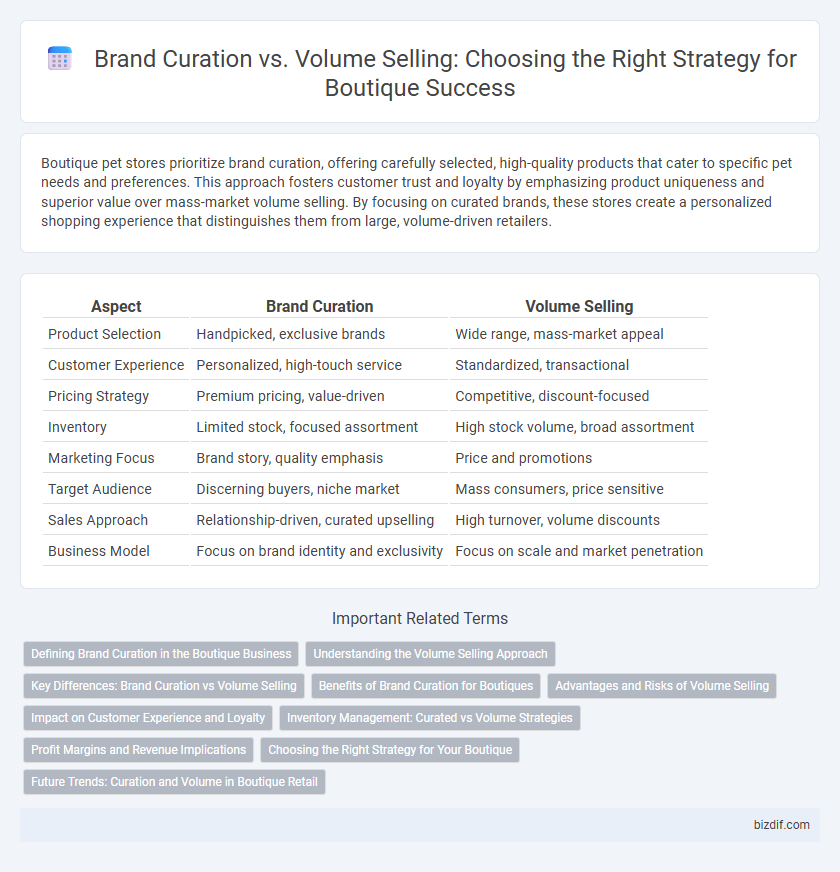Boutique pet stores prioritize brand curation, offering carefully selected, high-quality products that cater to specific pet needs and preferences. This approach fosters customer trust and loyalty by emphasizing product uniqueness and superior value over mass-market volume selling. By focusing on curated brands, these stores create a personalized shopping experience that distinguishes them from large, volume-driven retailers.
Table of Comparison
| Aspect | Brand Curation | Volume Selling |
|---|---|---|
| Product Selection | Handpicked, exclusive brands | Wide range, mass-market appeal |
| Customer Experience | Personalized, high-touch service | Standardized, transactional |
| Pricing Strategy | Premium pricing, value-driven | Competitive, discount-focused |
| Inventory | Limited stock, focused assortment | High stock volume, broad assortment |
| Marketing Focus | Brand story, quality emphasis | Price and promotions |
| Target Audience | Discerning buyers, niche market | Mass consumers, price sensitive |
| Sales Approach | Relationship-driven, curated upselling | High turnover, volume discounts |
| Business Model | Focus on brand identity and exclusivity | Focus on scale and market penetration |
Defining Brand Curation in the Boutique Business
Brand curation in the boutique business emphasizes selecting and showcasing a carefully crafted collection of unique, high-quality brands that align with the boutique's identity and customer preferences. This approach prioritizes exclusivity, storytelling, and customer experience over mass inventory, fostering loyalty through distinctive product offerings. By focusing on brand curation, boutiques enhance their market differentiation and build stronger emotional connections with discerning consumers.
Understanding the Volume Selling Approach
Volume selling emphasizes high turnover of products through mass-market appeal, leveraging economies of scale to reduce costs and increase accessibility. This approach relies on broad customer targeting and standardized offerings to maximize sales frequency rather than individualized experiences. Retailers using volume selling prioritize operational efficiency and aggressive pricing strategies to attract large consumer segments.
Key Differences: Brand Curation vs Volume Selling
Brand curation emphasizes selective inventory with high-quality, unique products tailored to niche markets, enhancing customer experience and brand identity. Volume selling prioritizes large quantities of mainstream items aimed at maximizing sales through broad appeal and competitive pricing. The key difference lies in brand curation's focus on exclusivity and storytelling, while volume selling targets mass consumption and rapid turnover.
Benefits of Brand Curation for Boutiques
Brand curation in boutiques enhances customer loyalty by offering a carefully selected range of unique and high-quality products tailored to specific tastes, differentiating the store from mass-market retailers. This strategic focus on curated brands drives higher profit margins and fosters a strong brand identity, attracting discerning shoppers seeking exclusivity. By emphasizing quality over quantity, boutiques can create personalized shopping experiences that encourage repeat visits and positive word-of-mouth promotion.
Advantages and Risks of Volume Selling
Volume selling leverages economies of scale to offer lower prices and attract a broader customer base, increasing overall revenue potential for boutiques. However, it risks diluting brand identity and compromising product quality, which can alienate loyal customers seeking exclusivity. High inventory demands also increase operational costs and the likelihood of unsold stock, impacting profitability and cash flow management.
Impact on Customer Experience and Loyalty
Brand curation enhances customer experience by offering a carefully selected range of high-quality products that resonate with niche preferences, fostering deeper emotional connections and trust. Volume selling prioritizes quantity over quality, often leading to lower customer satisfaction due to overwhelming choices and inconsistent product standards. Boutiques employing brand curation strategies benefit from higher customer loyalty through personalized service and unique, relevant product offerings.
Inventory Management: Curated vs Volume Strategies
Boutique inventory management thrives on brand curation, emphasizing selective stocking of high-quality, unique pieces tailored to niche customer tastes, which reduces overstock and enhances exclusivity. Volume selling strategies prioritize high turnover and wide product range, often relying on bulk purchasing and mass-market appeal to maximize sales. Effective inventory control in boutiques balances curated collections that build brand identity with volume tactics that maintain cash flow and product availability.
Profit Margins and Revenue Implications
Brand curation in boutiques emphasizes carefully selected, high-quality products that command higher profit margins compared to volume selling, which relies on large quantities of lower-margin items. This strategy enhances customer loyalty and allows for premium pricing, directly impacting revenue growth by attracting niche markets willing to pay more for exclusivity. While volume selling may generate higher overall sales, brand curation prioritizes sustainable profitability through differentiated product offerings and a focused inventory.
Choosing the Right Strategy for Your Boutique
Brand curation emphasizes selecting unique, high-quality products that align with your boutique's identity, fostering customer loyalty and enhancing brand prestige. Volume selling focuses on maximizing sales through a wide product range and competitive pricing, appealing to cost-conscious customers and increasing turnover. Choosing the right strategy depends on your target market, inventory capacity, and long-term business goals to ensure sustainable growth and market differentiation.
Future Trends: Curation and Volume in Boutique Retail
Boutique retail is shifting towards a balanced approach where brand curation enhances personalized customer experiences while selective volume selling drives scalable growth. Future trends indicate integration of data analytics to refine curated collections and optimize inventory turnover, blending exclusivity with efficient supply chain management. Emphasizing sustainability and local craftsmanship further differentiates curated brands, aligning with evolving consumer values in boutique markets.
Brand Curation vs Volume Selling Infographic

 bizdif.com
bizdif.com